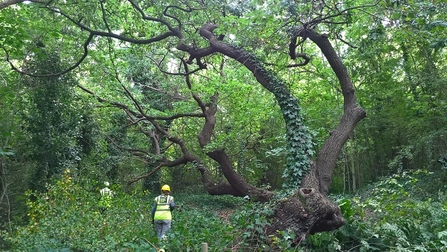One Tree Hill rises majestically at the northern end of the Great North Wood and offers a wonderful view of central London. This Local Nature Reserve is designated as a Grade 1 Site of Borough Importance for Nature Conservation and has a fascinating mixture of historical and ecological features.
London Wildlife Trust launched the Great North Wood project in 2017 and now works with volunteers, community groups, landowners, and councils, to revive and reimagine this ancient landscape as a home for nature and people.
History
Formerly known as Oak of Honour Wood, One Tree Hill was once a working woodland at the northern extent of the Great North Wood. According to local legend, Elizabeth I once rested beneath an oak on this hilltop on a journey to Lewisham, giving rise to the names Honor Oak and One Tree Hill. ‘Honor’ is in fact an archaic spelling and not an Americanism! The current ‘one tree’ is the third such incumbent, planted in 1905 after the previous tree was destroyed by lightning in 1888.
The dominance of the summit in the local landscape and its commanding view of the area meant that at different times in its history One Tree Hill has been the site of a semaphore station built by the East India Company, a signal beacon during the Napoleonic Wars, and an anti-Zeppelin gun emplacement in the First World War. Its steep slopes are also the source of the River Peck, a largely forgotten river now most easily seen in short stretches running through nearby Peckham Rye Park.
Having been largely clear-felled by the 19th Century, in 1896 the site was then enclosed and converted into a golf course, but incensed locals (allegedly spurred on by free beer from a local brewer) rioted on the hill in protest, ultimately leading to its purchase in 1905 by the (now defunct) Camberwell Borough Council, as a public open space.
Ecology
One Tree Hill is a youthful secondary woodland, mostly comprising colonising species such as ash, sycamore and wild cherry, in dense knots of saplings. In among these are hidden a few mighty boundary oaks – planted to delineate property and parish boundaries – as well as the majestic Oak of Honor on the hilltop.
Interestingly, the other principal tree species is London plane, a tree that we are more familiar with on park avenues or patrolling pavements alongside our major roads. At One Tree Hill, these plane trees are the remnants of the formal park planted in the early 20th Century and are now largely hidden among the woodland that has sprung up over the last 50 years since park-style management ceased. Important areas of blackthorn and hawthorn scrub have been allowed to develop, and the site also retains sunnier woodland glades and meadows to complement its darker areas of young woodland.


